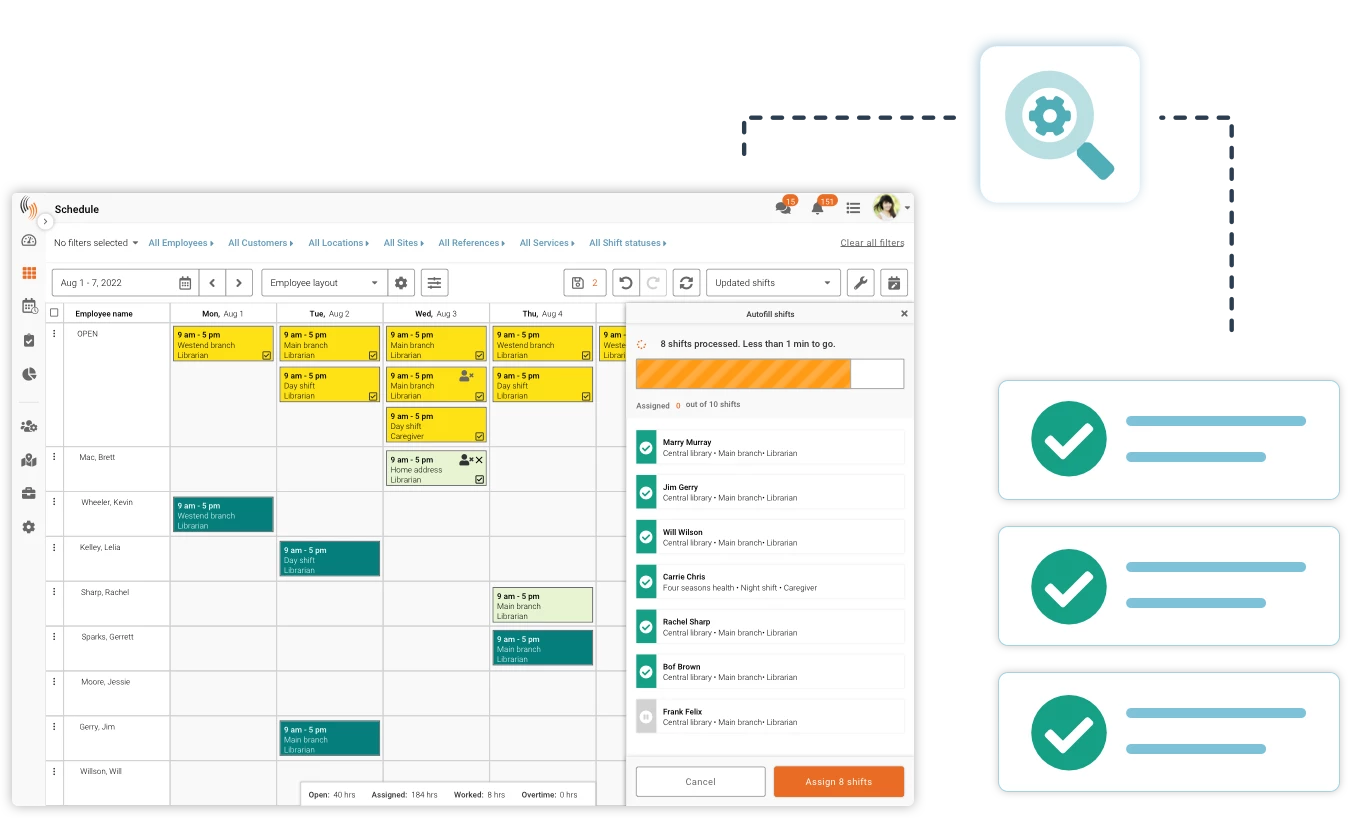Fun fact; according to a report from Emergence, 80% of the global workforce (that’s 2.7 billion people) does not sit behind a desk to do their job. Consider industries like healthcare, construction, manufacturing, and security. This deskless workforce is often forgotten about with the development of new technology. This is a shame, considering that more than 78% of deskless workers surveyed consider the availability of appropriate technology to be an important factor when looking for a new job.
This is easy to imagine. Consider a nurse handling patient records regarding medication etc. Using pen and paper to record these notes and then having to complete a handover takes up a significant amount of time.
With the right technology, however, nurses can automatically record medication administration, with records that can be accessed by any and all necessary employees. This is just one example of how technology can empower a deskless workforce.
What is a Deskless Workforce?
A deskless workforce is comprised of employees who do not sit at a desk to complete their job. Often, deskless workers are thought to be “blue-collar” workers, or in specific industries. However, some white-collar workers are part of the deskless workforce too! Essentially, it doesn’t matter what industry we look at, there is generally some line of work in any field that is “deskless”.
This might be one of the reasons that technology for the deskless workforce tends to lag behind other forms of workplace technology. With office workers, who typically use a desk, the technology is agnostic (the same) regardless of their industry.
Most desk workers use a computer/laptop. That laptop likely has a word processor on there. You get the gist.
Unfortunately, the technological requirements for a nurse are far different from those of a construction worker, right? However, here at Celayix, we’ve come to learn that the needs of deskless employees and other workers boil down to the same basic ideas.
The Needs of a Deskless Workforce
When we strip back the needs of any worker, there are some common elements, regardless of their working environment. Most of these needs are in relation to workforce management.
Communication
First, let’s consider communication. Just like any other workers, deskless workers need to be able to communicate effectively with their team. They need to be clear on company goals, manager expectations, and tuned into what is happening in the workplace around them.
Without the right communication channels and tools, the deskless workforce along with their counterparts are susceptible to poor employee engagement. As we’ve discussed here before, that spells bad news for the entire organization.
Work-life Balance
There is no doubt that absolutely every employee, regardless of being deskless or not should be able to achieve work-life balance. Unfortunately, the deskless workforce is one that generally operates in 24/7 industries. This means they have to work irregular shift patterns and are more likely to miss key events due to their schedule. Without the right workforce management tools, it can be hard for schedulers and managers to provide the work-life balance that the diskless workforce deserves.
Flexibility & Autonomy
In recent years, more and more offices are adopting fully remote or hybrid working models. However, this really only applies to a traditional office settings.
Healthcare providers and frontline workers can’t work from home when they want? Security guards cannot carry out virtual patrols? So, it’s just a little bit unfair, right? However, there are resources out there that can provide flexibility and autonomy to deskless shift workers.
They may not be able to work from the comfort of their home, but there are other ways to achieve flexibility. In fact, 25 percent of deskless workers would forgo a higher salary if they could have more flexibility. Workforce management tools such as employee scheduling software have the capacity to provide flexible scheduling options. We’ll cover that in more detail below.
What is Workforce Management?
In a previous blog post, we break down what exactly workforce management is. In essence, workforce management is a set of strategies, tools, and processes working together to ensure maximum productivity & efficiency. The basic idea of workforce management (WFM) is having the right people in the right place, at the right time.
As you can imagine, this can look very different for both deskless workforces and their counterparts. With a deskless workforce, there may be multiple sites, field workers, remote workers, and more. It can be difficult to keep tabs on everyone as a manager without having eyes in the back of your head!
There are 4 main areas in workforce management. We’re going to break them down below in relation to deskless workforces, and how to get the most out of them!
Forecasting and Budgeting
One of the main goals of workforce management is having the right people, in the right place, at the right time. As you can imagine, this is pretty easy when it comes to office workers. Most of them work Mon-Fri, 9-5 or some variation of that traditional pattern.
However, this is far more challenging when it comes to a deskless workforce. Forecasting a deskless workforce is difficult due to different shift patterns, fluctuating demand, and other factors. Not only is forecasting this difficult but allocating budget to this is also a challenge.
When it comes to a deskless workforce, it can help to review historical data from your business in search of patterns. These patterns can identify key periods or timeframes that might need to be increased/decreased workforces.
It might also identify key market/industry trends that can help with labor forecasting as well as budgeting. There are workforce management tools and resources out there to help with recording, reviewing, and consolidating this information. (Like Celayix!)
Employee Scheduling
Obviously, employee scheduling is one of the main drivers to have the right people in the right place at the right time. Again, when dealing with multiple shift patterns, multiple roles, and many potential work locations, creating an effective employee schedule is far from easy.
Of course, manual scheduling is not the ideal way of managing all of these moving parts. Manual schedulers often end up relying on overtime to fill schedule gaps, which ultimately ends up hurting the organization. Double bookings and other scheduling errors also impact deskless workers and their productivity.
Best-of-breed workforce management tools often contain employee scheduling tools that can help to create a well-optimized schedule. Deskless workers, as we mentioned above deserve and should be entitled to schedule flexibility. The difficulty of managing a deskless workforce is not the fault of the workforce themselves.
So, organizations should invest in the right tools and software to help provide these options. Celayix provides schedulers with artificial intelligence and a rules-based engine to automate the creation of fully optimized schedules. Celayix also provides flexible scheduling tools such as shift bidding and self-scheduling. These tools help shift/deskless workers manage their work schedules on a more autonomous level, and ultimately achieve work-life balance.
Time and Attendance Tracking
A key part of having the right people in the right place and the tight time, is being able to record and verify where employees actually are. Going back to office workers, it’s generally safe to assume that they are in the office/at their desk for the majority of the workday.
Most desk workers do not have to clock in/out of work. This is not the case for a deskless workforce. Are they on-site? Are they in the building? Were they on time? These are all critical questions in relation to workforce management.
One of the most important factors to consider is the method of time collection. There are manual/outdated methods of employee check-in, such as sign-in sheets and paper timesheets.
However, these methods are vulnerable to buddy punching and other time fraud practices from employees. Buddy punching and other forms of time theft can cost your business up to 7% of your total payroll. When budgets are tight and margins are thin, this should be avoided at all costs.
Automated time and attendance tracking systems (such as Celayix) can prevent this, and save both time and money. Our advanced workforce management platform has GPS geofencing functionality which makes managing a deskless workforce a breeze! See where employees are while they’re on the clock, and what time arrive/leave. You can also get instant alerts for late check-ins and no-shows, which is very beneficial for the manager of a deskless workforce with multiple sites.
Employee Engagement
We truly believe that employee engagement is the final piece of the workforce management puzzle. You can rest knowing you have the right people in the right place at the right time. Now you just need to ensure they’re truly engaged, and in turn, being productive.
Research shows that workplaces with engaged employees outperformed those with unengaged employees in almost every field; 10% on customer ratings, 17% in productivity, 20% in sales, and 21% in profitability. Employee engagement is a slow burner, but getting all of the above factors certainly sets you on the right path.
If you’d like to learn more about how Celayix can help you manage your deskless workforce, get in touch with Celayix Solutions Advisor today!










